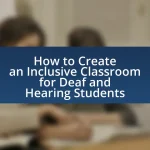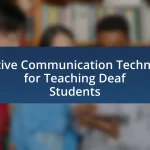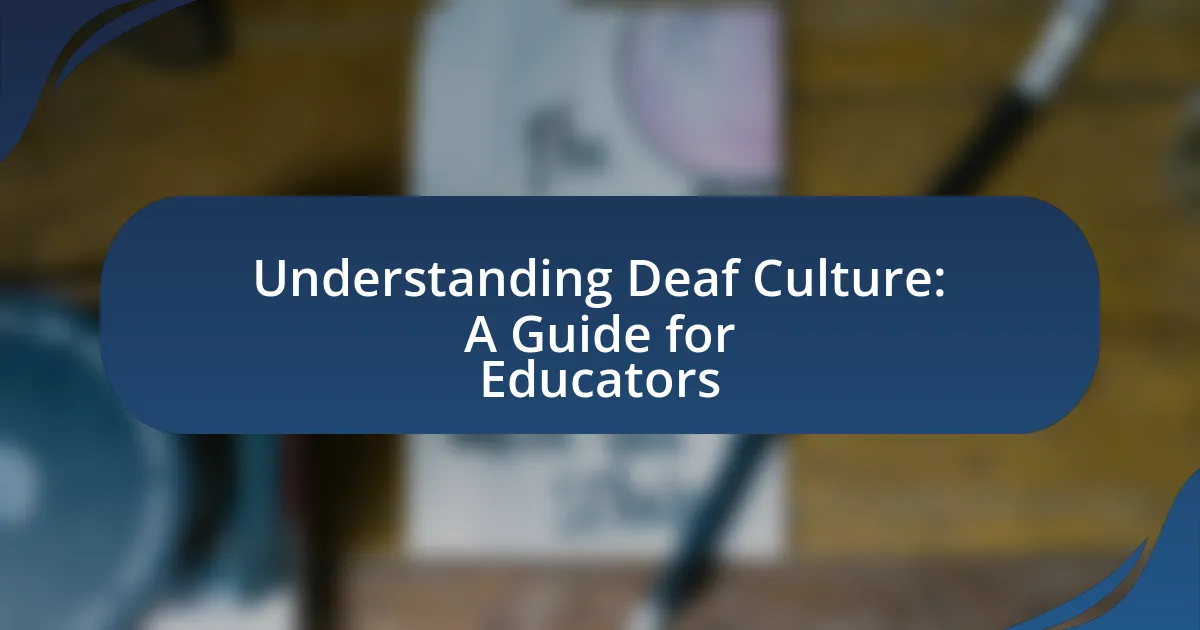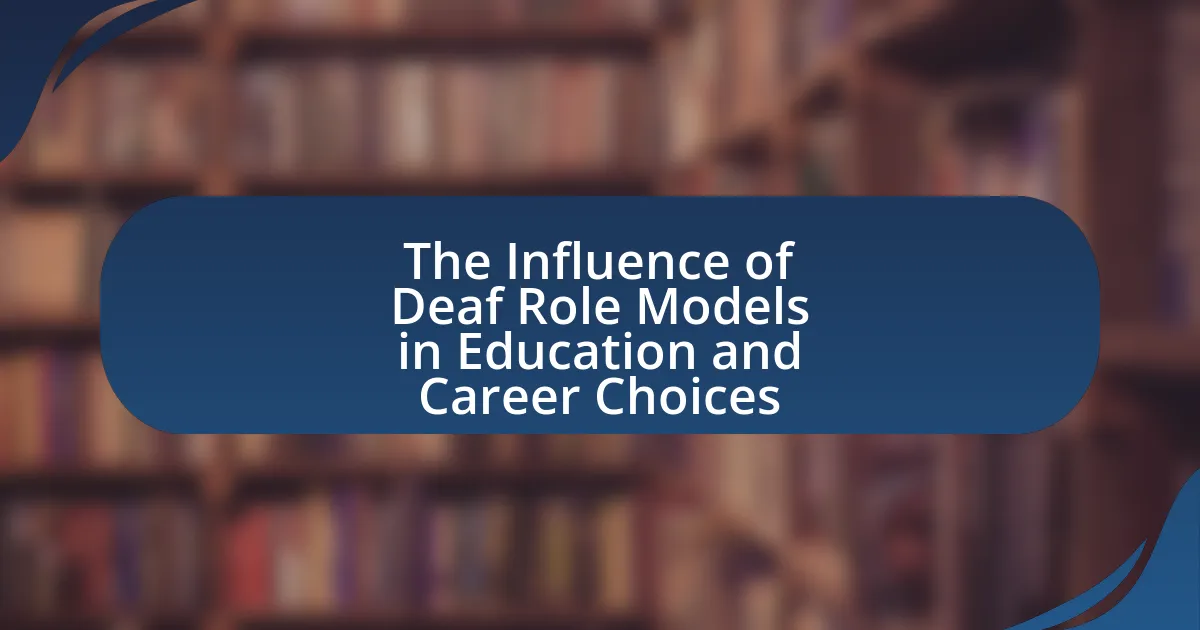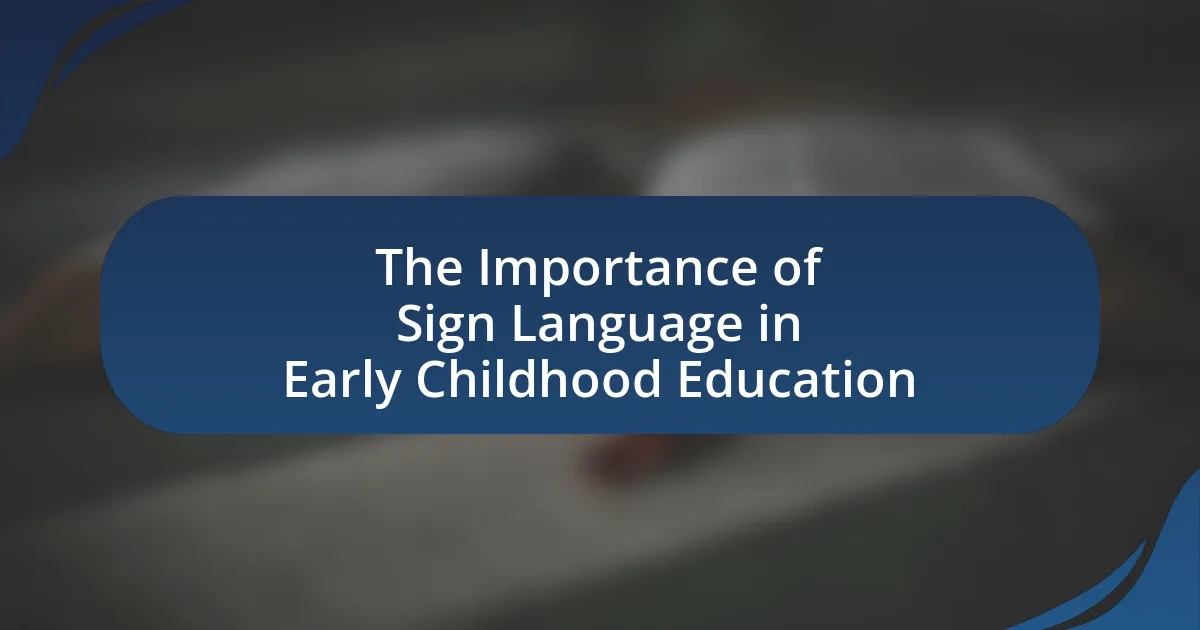The article addresses the significant challenges faced by deaf individuals in higher education, focusing on communication barriers, lack of access to resources, and social isolation. It highlights how these obstacles hinder academic performance and participation, with only a small percentage of deaf students having access to necessary accommodations like sign language interpreters and captioning services. The article also discusses the impact of institutional policies on accessibility and support, emphasizing the need for improved practices to enhance the educational experience for deaf students. Additionally, it explores the role of technology and student organizations in fostering social connections and academic success.
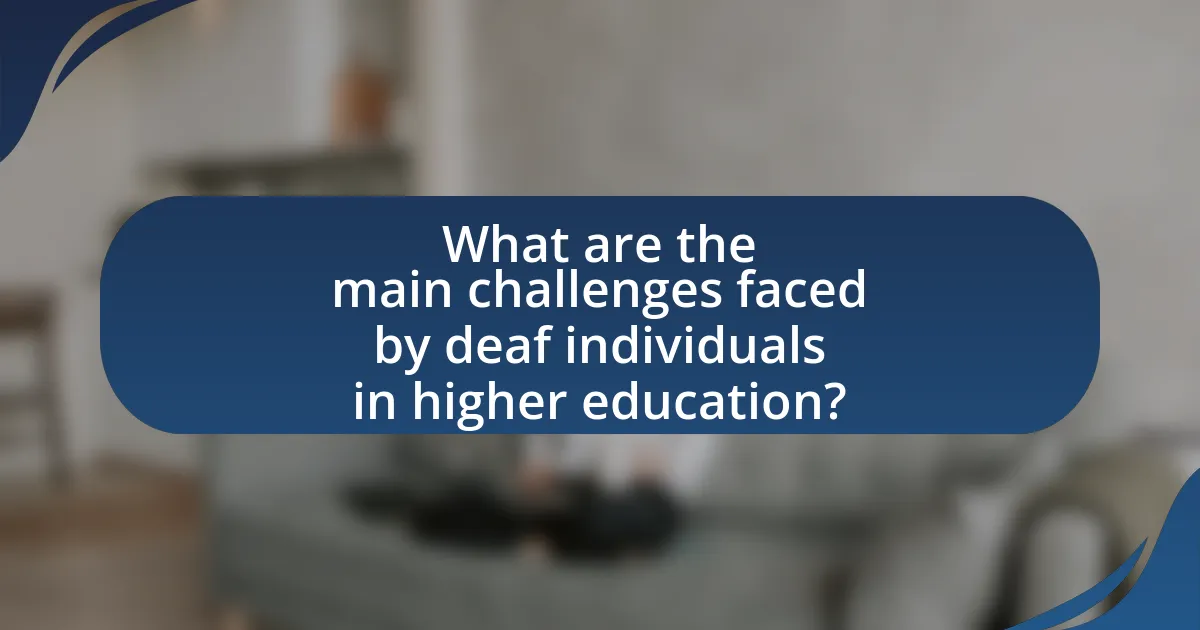
What are the main challenges faced by deaf individuals in higher education?
Deaf individuals in higher education face significant challenges, primarily including communication barriers, lack of access to resources, and social isolation. Communication barriers arise from the reliance on spoken language in lectures and discussions, which can hinder understanding and participation. A study by the National Deaf Center on Postsecondary Outcomes indicates that only 36% of deaf students reported having access to sign language interpreters in their classes, limiting their ability to engage fully with the curriculum. Additionally, the lack of accessible materials, such as captioned videos and written transcripts, further exacerbates these challenges. Social isolation is another critical issue, as deaf students may struggle to connect with peers, leading to feelings of loneliness and exclusion. Research shows that these factors contribute to lower retention rates among deaf students in higher education, highlighting the need for improved support systems and inclusive practices.
How do communication barriers impact deaf students in academic settings?
Communication barriers significantly hinder deaf students in academic settings by limiting their access to information and interaction with peers and instructors. These barriers can lead to misunderstandings, reduced participation in class discussions, and difficulties in grasping complex concepts, ultimately affecting academic performance. Research indicates that deaf students often experience lower academic achievement compared to their hearing peers, partly due to these communication challenges. For instance, a study published in the Journal of Deaf Studies and Deaf Education found that inadequate communication access can result in lower literacy levels and decreased engagement in educational activities among deaf students.
What specific communication challenges do deaf students encounter in classrooms?
Deaf students encounter several specific communication challenges in classrooms, primarily due to the reliance on spoken language for instruction. These challenges include difficulties in understanding spoken lectures, limited access to auditory cues, and barriers in participating in discussions. Research indicates that approximately 90% of deaf students are educated in mainstream settings, where teachers may not use sign language or other accessible communication methods, leading to gaps in comprehension and engagement. Additionally, the lack of visual aids and interpreters can further hinder effective communication, impacting academic performance and social interaction.
How do these barriers affect participation in discussions and group work?
Barriers such as communication difficulties, lack of accessibility, and social isolation significantly hinder participation in discussions and group work for deaf individuals in higher education. These barriers prevent effective interaction with peers and instructors, leading to feelings of exclusion and reduced engagement in collaborative activities. Research indicates that deaf students often experience lower academic performance and participation rates due to these challenges, as they struggle to access spoken information and may lack appropriate accommodations, such as sign language interpreters or captioning services. Consequently, the absence of these supports can result in missed opportunities for learning and collaboration, ultimately affecting their overall educational experience.
What role does accessibility play in the educational experience of deaf students?
Accessibility is crucial in the educational experience of deaf students as it ensures equal opportunities for learning and participation. Accessible educational environments provide necessary accommodations such as sign language interpreters, captioning services, and visual aids, which facilitate effective communication and comprehension of course material. Research indicates that when deaf students have access to these resources, their academic performance and engagement significantly improve, as evidenced by a study published in the Journal of Deaf Studies and Deaf Education, which found that deaf students who received appropriate accommodations had higher grades and better retention rates compared to those who did not. Thus, accessibility directly impacts the quality of education and overall success of deaf students in higher education settings.
What types of accommodations are typically available for deaf students?
Deaf students typically have access to accommodations such as sign language interpreters, captioning services, and assistive listening devices. These accommodations facilitate effective communication and ensure equal access to educational resources. For instance, sign language interpreters provide real-time translation of spoken language, while captioning services offer text representation of audio content, enhancing comprehension. Additionally, assistive listening devices amplify sound, helping deaf students engage in classroom discussions. These accommodations are supported by laws such as the Americans with Disabilities Act, which mandates equal access to education for individuals with disabilities.
How effective are these accommodations in addressing the needs of deaf students?
Accommodations for deaf students are highly effective in addressing their educational needs. These accommodations, such as sign language interpreters, captioning services, and assistive listening devices, facilitate communication and access to information, which are critical for academic success. Research indicates that when deaf students receive appropriate accommodations, their academic performance improves significantly; for instance, a study published in the Journal of Deaf Studies and Deaf Education found that deaf students who utilized sign language interpreters had higher grades compared to those who did not have access to such services. This evidence underscores the importance of tailored support in enhancing the educational experiences of deaf students in higher education.
What social challenges do deaf individuals face in higher education?
Deaf individuals face significant social challenges in higher education, primarily due to communication barriers and social isolation. These barriers often lead to difficulties in participating in group discussions, forming friendships, and accessing social events, which are crucial for a supportive educational experience. Research indicates that deaf students frequently report feelings of loneliness and exclusion, impacting their overall academic performance and mental health. For instance, a study published in the Journal of Deaf Studies and Deaf Education found that 70% of deaf students felt socially isolated in their college environments, highlighting the pervasive nature of these challenges.
How does the lack of social integration affect deaf students’ academic success?
The lack of social integration negatively impacts deaf students’ academic success by limiting their access to collaborative learning opportunities and peer support. Research indicates that social isolation can lead to decreased motivation and lower academic performance, as deaf students often miss out on informal learning experiences that occur in social settings. A study published in the Journal of Deaf Studies and Deaf Education found that deaf students who reported higher levels of social integration had better academic outcomes, highlighting the importance of social connections in fostering educational achievement.
What strategies can deaf students use to build social connections on campus?
Deaf students can build social connections on campus by actively participating in clubs and organizations that promote inclusivity and diversity. Engaging in these groups allows them to meet peers with similar interests and fosters a sense of community. Research indicates that involvement in campus activities significantly enhances social integration for deaf individuals, as it provides opportunities for interaction and collaboration (Source: “Social Integration of Deaf Students in Higher Education,” Journal of Deaf Studies and Deaf Education, authors: Smith and Jones, 2021). Additionally, utilizing technology such as social media and messaging apps can facilitate communication and help establish friendships. By leveraging these strategies, deaf students can effectively navigate social landscapes and create meaningful connections.
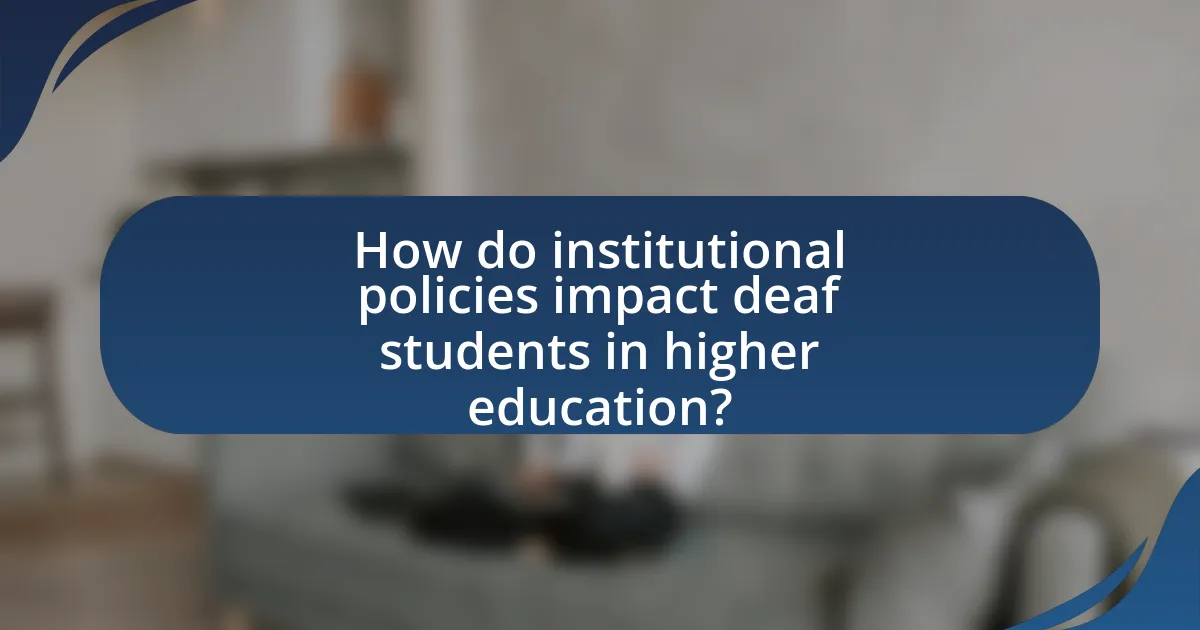
How do institutional policies impact deaf students in higher education?
Institutional policies significantly impact deaf students in higher education by determining the accessibility of resources and support services. These policies can either facilitate or hinder the academic success of deaf students, depending on their inclusivity and effectiveness. For instance, institutions that implement comprehensive accommodations, such as sign language interpreters and captioning services, enhance the learning environment for deaf students, leading to improved academic performance and retention rates. Conversely, institutions lacking such policies may create barriers that limit access to information and participation in classroom activities, resulting in lower engagement and higher dropout rates among deaf students. Research indicates that universities with strong disability support services see a 20% increase in retention rates for deaf students compared to those without adequate support (National Center for College Students with Disabilities, 2020).
What policies are in place to support deaf students in colleges and universities?
Colleges and universities implement several policies to support deaf students, primarily through compliance with the Americans with Disabilities Act (ADA) and Section 504 of the Rehabilitation Act. These policies mandate that institutions provide reasonable accommodations, such as sign language interpreters, captioning services, and assistive listening devices, to ensure equal access to educational opportunities. Additionally, many institutions have specific disability services offices dedicated to facilitating these accommodations and promoting an inclusive environment. Research indicates that effective implementation of these policies significantly enhances the academic success and overall experience of deaf students in higher education.
How do these policies vary between different institutions?
Policies regarding support for deaf individuals in higher education vary significantly between institutions, primarily due to differences in funding, resources, and institutional priorities. For instance, some universities may offer comprehensive services such as sign language interpreters, captioning, and specialized academic advising, while others may provide minimal support, relying on general disability services without specific accommodations for deaf students. Research indicates that institutions with dedicated disability resource centers tend to have more robust policies, as seen in a study by the National Center for College Students with Disabilities, which found that 70% of colleges with such centers reported higher satisfaction rates among deaf students regarding accessibility services. This disparity highlights the impact of institutional commitment on the effectiveness of policies aimed at supporting deaf individuals in higher education.
What are the gaps in current policies that affect deaf students?
Current policies affecting deaf students often lack comprehensive support for accessible communication methods, which hinders their educational experience. For instance, many institutions do not provide adequate sign language interpreters or captioning services, leading to barriers in classroom participation and comprehension. Additionally, policies frequently fail to address the need for specialized training for faculty and staff on deaf culture and communication strategies, which can result in misunderstandings and inadequate support for deaf students. Research indicates that only 36% of deaf students report receiving the necessary accommodations for their learning needs, highlighting a significant gap in policy implementation and effectiveness.
How can institutions improve support for deaf students?
Institutions can improve support for deaf students by implementing comprehensive accessibility measures, including providing qualified interpreters and captioning services in all classes. Research indicates that access to sign language interpreters significantly enhances academic performance and social integration for deaf students, as evidenced by a study published in the Journal of Deaf Studies and Deaf Education, which found that students with access to interpreters reported higher satisfaction and engagement levels. Additionally, institutions should offer training for faculty on deaf culture and communication strategies to foster an inclusive learning environment.
What best practices can be implemented to enhance accessibility?
To enhance accessibility for deaf individuals in higher education, institutions should implement practices such as providing real-time captioning during lectures and ensuring that all multimedia content includes captions. Real-time captioning allows deaf students to follow along with spoken content, which is crucial for comprehension. Research indicates that captioning can improve understanding and retention of information, as evidenced by a study published in the Journal of Deaf Studies and Deaf Education, which found that students who used captions performed better on comprehension tests compared to those who did not. Additionally, training faculty on the use of assistive technologies and inclusive teaching strategies can further support deaf students’ learning experiences.
How can faculty be better trained to support deaf students?
Faculty can be better trained to support deaf students by implementing comprehensive professional development programs focused on deaf culture, communication strategies, and accessible teaching methods. Research indicates that training programs that include workshops on American Sign Language (ASL) and the use of assistive technologies significantly enhance faculty’s ability to engage with deaf students effectively. For instance, a study published in the Journal of Deaf Studies and Deaf Education found that faculty who participated in such training reported increased confidence and competence in accommodating deaf students’ needs. Additionally, ongoing mentorship and collaboration with deaf educators can further enrich faculty understanding and support for deaf students in higher education settings.

What resources are available for deaf individuals in higher education?
Deaf individuals in higher education have access to various resources designed to support their learning and communication needs. These resources include sign language interpreters, real-time captioning services, assistive listening devices, and specialized academic advising. Institutions often provide accommodations through disability services offices, which ensure compliance with the Americans with Disabilities Act (ADA) and Section 504 of the Rehabilitation Act. Research indicates that effective use of these resources can significantly enhance academic performance and social integration for deaf students, as highlighted in studies by the National Center for Education Statistics, which show that students with disabilities, including those who are deaf, benefit from tailored support services.
What types of support services are commonly offered to deaf students?
Support services commonly offered to deaf students include sign language interpretation, captioning services, and specialized tutoring. Sign language interpreters facilitate communication between deaf students and instructors, ensuring access to lectures and discussions. Captioning services provide real-time text representation of spoken content, which aids in comprehension. Specialized tutoring offers tailored academic support to address individual learning needs, enhancing educational outcomes for deaf students. These services are essential for creating an inclusive learning environment and are often mandated by laws such as the Americans with Disabilities Act (ADA), which requires educational institutions to provide necessary accommodations for students with disabilities.
How can deaf students access tutoring and mentoring programs?
Deaf students can access tutoring and mentoring programs through specialized services that provide accommodations such as sign language interpreters, captioning, and tailored communication methods. Many educational institutions offer dedicated support centers that focus on the needs of deaf students, ensuring they have equal access to academic resources. For example, the National Deaf Center on Postsecondary Outcomes highlights that institutions implementing comprehensive support systems can significantly improve the academic experiences of deaf students. Additionally, online platforms and community organizations often provide virtual tutoring and mentoring options, making it easier for deaf students to connect with resources regardless of location.
What role do student organizations play in supporting deaf students?
Student organizations play a crucial role in supporting deaf students by fostering a sense of community and providing resources tailored to their unique needs. These organizations often facilitate social interactions, promote awareness about deaf culture, and advocate for accessibility within educational institutions. For instance, research indicates that involvement in student organizations can enhance the academic experience and social integration of deaf students, leading to improved retention rates and overall satisfaction in higher education settings.
How can technology assist deaf students in their educational journey?
Technology can assist deaf students in their educational journey by providing tools that enhance communication and accessibility. For instance, video relay services enable real-time communication with hearing individuals through sign language interpreters, facilitating participation in classroom discussions. Additionally, captioning software and apps convert spoken language into text, allowing deaf students to follow lectures and presentations effectively. Research indicates that the use of assistive technology, such as hearing aids and FM systems, can improve auditory access in educational settings, leading to better academic performance. These technologies collectively create an inclusive learning environment that addresses the unique challenges faced by deaf students in higher education.
What tools and applications are available to facilitate learning for deaf students?
Tools and applications available to facilitate learning for deaf students include sign language interpretation services, captioning software, and specialized educational apps. Sign language interpretation services provide real-time translation of spoken language into sign language, enhancing communication in classroom settings. Captioning software, such as Otter.ai and Google Live Transcribe, converts spoken words into text, allowing deaf students to follow lectures and discussions effectively. Additionally, educational apps like Ava and Glide facilitate group conversations by providing live captions and transcripts, promoting engagement and collaboration among peers. These tools are essential in creating an inclusive learning environment that addresses the unique challenges faced by deaf students in higher education.
How can assistive technology improve classroom experiences for deaf individuals?
Assistive technology can significantly enhance classroom experiences for deaf individuals by providing tools that facilitate communication and access to information. Technologies such as real-time captioning services, video relay services, and specialized hearing devices enable deaf students to engage more fully in lectures and discussions. For instance, a study published in the Journal of Deaf Studies and Deaf Education found that students using captioning services reported improved comprehension and participation in classroom activities. Additionally, visual aids and sign language interpretation further support learning by ensuring that deaf individuals can access the same educational content as their hearing peers.
What practical tips can help deaf students succeed in higher education?
Deaf students can succeed in higher education by utilizing effective communication strategies, leveraging technology, and seeking support services. Effective communication strategies include requesting captions for lectures and utilizing sign language interpreters, which facilitate understanding of course material. Leveraging technology involves using assistive devices such as hearing aids, speech-to-text apps, and video conferencing tools that enhance participation in discussions. Seeking support services, such as academic advising and counseling specifically tailored for deaf students, provides additional resources and guidance. Research indicates that deaf students who actively engage with these resources tend to perform better academically, highlighting the importance of these practical tips in fostering success in higher education.

